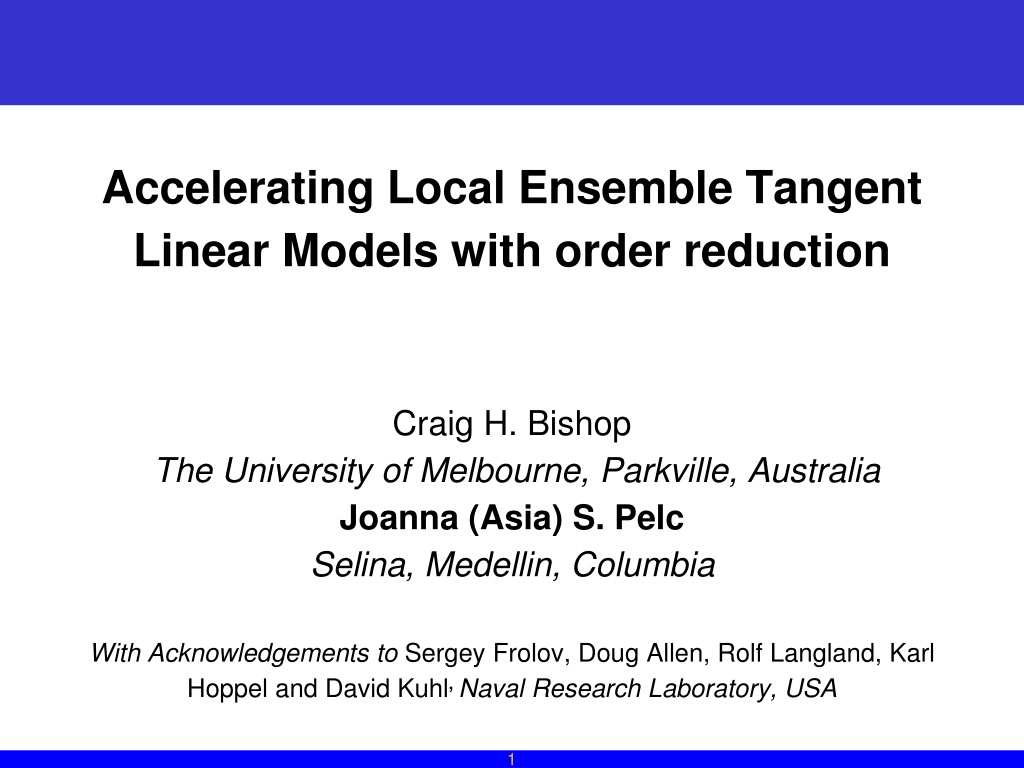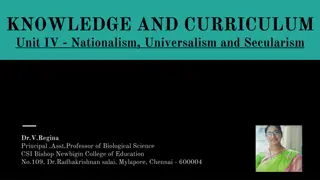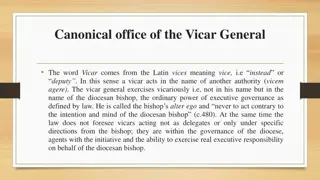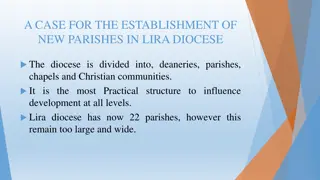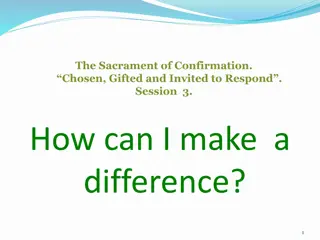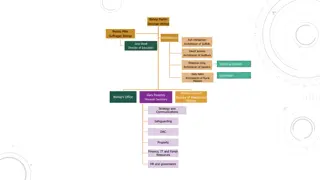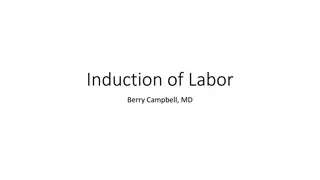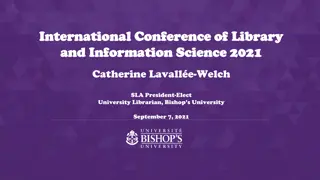Accelerating Local Ensemble Tangent Linear Models
This research focuses on accelerating Local Ensemble Tangent Linear Models with order reduction, exploring methods, results, and implications for advancing numerical modeling in atmospheric and oceanic systems. The study addresses challenges in maintaining accurate TLMs and adjoints for coupled models, emphasizing the importance of automating approximations and enablers for strongly coupled 4DVAR. By investigating predictability in a coupled model ensemble, the research aims to improve understanding and forecasting in complex environmental systems.
Download Presentation

Please find below an Image/Link to download the presentation.
The content on the website is provided AS IS for your information and personal use only. It may not be sold, licensed, or shared on other websites without obtaining consent from the author.If you encounter any issues during the download, it is possible that the publisher has removed the file from their server.
You are allowed to download the files provided on this website for personal or commercial use, subject to the condition that they are used lawfully. All files are the property of their respective owners.
The content on the website is provided AS IS for your information and personal use only. It may not be sold, licensed, or shared on other websites without obtaining consent from the author.
E N D
Presentation Transcript
Accelerating Local Ensemble Tangent Linear Models with order reduction Craig H. Bishop The University of Melbourne, Parkville, Australia Joanna (Asia) S. Pelc Selina, Medellin, Columbia With Acknowledgements to Sergey Frolov, Doug Allen, Rolf Langland, Karl Hoppel and David Kuhl, Naval Research Laboratory, USA 1
Outline Motivation LETLM method LETLM results Acceleration of LETLM with order reduction Results using reduced order LETLM Conclusions 2
Background and Motivation True TLM matrix perfectly predicts the difference between any two nonlinear model trajectories whose initial state differs by an infinitesimal amount. Its transpose or adjoint gives the rate of change of each forecast variable with respect to each initial condition variable. It is an essential ingredient for 4DVAR DA, FSOI and some variations of ensemble DA The prospect of maintaining accurate TLM and adjoints of coupled ocean-atmosphere-ice-aerosol-LSM-chem models is daunting. Because of statements like If A > 0 call parameterization , environmental models do not have true TLMs. Artful approximations must be made. How to automate? 3
The Local Ensemble TLM: a possible enabler for strongly coupled 4DVAR Variables in a very local region around a model variable determine its change over a time step. Typically, only 27 350 variables will have any influence on the evolution of a single variable over a single time step. x x x x x x x x x x x x x x x x x x x x x x In a 2D model x11 s evolutionmight only be affected by the variables within this local patch. 1 2 3 4 5 6 7 8 9 10 11 12 13 + x x x 1 14 15 16 17 18 x ( ) ( ) x 2 + = + T c m 1, x t t i i 19 20 2 1 11 x n ( , ) ( ) + = = perturbation at central point = n x 11 at x t t c t t 11 x , , perturbation in influence volume at x t 1 2 4
The Local Ensemble TLM: an enabler for strongly coupled 4DVAR If an ensemble of K perturbations are small enough to (automatically) satisfy the linearized governing equations then , , ,..., ,..., x x x x x x 11 12 1 K ( ) ( ) ( ) ( ) 21 22 2 K + + + = + T c m , ,..., 1, ; x t t x t t x t t i i 1 2 c c cK , ,..., x x x 1 2 n n nK ( ) = + T c m X or 1, i i c c T c m is row vector giving the local TLM for the th model grid poin ( ( ) 1, This relation is PRECISELY correct for ensemble perts in the linear For large ensemble and perts in the non-linear regime, where Hence, if ensemble size t c ) = X and rank , the local TLM is given by n K n m ( ) 1 + = T c T c T c m X X X i i c c regime. is the BLUE of evolution. ( ) + T ci m 1, i 5
Predictability of coupled model 16 members of atmosphere-ocean ensemble forecast 6
Construction of Local Ensemble TLM (LETLM) for simple coupled model Simple coupled model (based on Model 1 of Lorenz, 2005) uses 2nd order Runge-Kutta time stepping. Vertical coupling via relaxation to neighbouring levels. Thus, patch size required 2-3 levels of 9 grid points. Hence, needed K>27 ensemble members to precisely describe the linear dynamics regardless of total number of variables in the model (240). 7
Tests of coupled LETLM with K=28 ensemble members Mean square difference of LETLM and non-linear pert divided by mean square of non-linear pert over 5 day period is 0.0007. For ETLM, this ratio is 0.7. Black: Difference between 2 non-linear trajectories (perfect TL predicts this Cyan line is global ETLM with K=480 members: (Tracks black line perfectly) Red line is LETLM: (Often hidden by black line) Blue line is global ETLM with 28 members: (Terrible performance) 8
LETLMs enable 4DVAR: Convergence of outer loop over 5 day window Mean square error Outer loop iteration Convergence of mean square error (the ordinate axis) of the 4DVAR four-dimensional guess trajectory from 0 hr to 120 hrs in 6 hr intervals as a function of outer-loop iteration number (the abscissa axis) for LETLM enabled strong-constraint 4DVAR over 10 outer loops. (See Bishop et al. 2017, QJRMS, for details) 9
Motivation for accelerating LETLM At T47, poorly tuned LETLM is better than TLM currently used for operational 4DVAR and FSOI TLM LETLM (360 members) However, 1. A single run of LETLM takes ~10 times longer than the operational TLM. (Additional runs might be shorter) 2. Cost of ensemble size required for accuracy is burdensome. For 360 members LETLM NRMSE (01-60) = 0.337 TLM NRMSE (01-60) = 0.350 (Frolov et al. 2018, MWR) 10
Motivation for accelerating LETLM At T47, poorly tuned LETLM is better than TLM currently used for operational 4DVAR and FSOI TLM LETLM (360 members) However, 1. A single run of LETLM takes ~10 times longer than the operational TLM. (Additional runs might be shorter) 2. Cost of ensemble size required for accuracy is burdensome. For 360 members LETLM NRMSE (01-60) = 0.337 TLM NRMSE (01-60) = 0.350 Method would be more attractive if it was faster! 11
Idea for reducing order of LETLM The LETLM for each model variable is just a row vector In climate studies, they find reduced order representations of statevectors using the eigenvectors or EOFs of the covariance matrix of the climatological distribution of statevectors. Why not try the same thing with LETLM vectors? 12
Idea for reducing order of LETLM Each black line is a realization from a climatology of states. Pick the red one, say, and compute and store the LETLM vectors for it. Now do the same for every other climatological state. One now has a climatology of LETLM vectors. Compute the mean vector and covariance matrix of the climatological distribution of LETLM vectors found at each vertical level. 13
LETLM Reduced using LETLM Climate LETLM-RLC 1 J J = j m m is the mean of the LETLMs c c = 1 j ( ) ( ) ( ) = 1 c 2 c mat c J c M m m m m m m , , , are the perts about the mean c c c 1 ( ) T = mat c mat c C M M is the climatological covariance matrix of LETLMs c 1 J N r = = T T T trunc C e i i e e i i e E E is an accurate but reduced order c i i trunc trunc = = C 1 1 i i representation of in terms of its leading eigenvectors. r c With little or no loss of accuracy, any LETLM from the climatology has the form + 1/2 trunc m T c T T trunc m m b E , c T c T b Note that while has elements, n only has elements. r T b is the LETLM Reduced using a LETLM Climate or LETLM-RLC 14
Derivation of LETLM-RLC ( ( ) ) + = T c m X 1 i m m + = + 1/2 T c T T trunc m X b E X 1 i m m m = + 1/2 T c T T trunc m X b A A E X , where = m m Note that A, the matrix of scaled projections of the leading eigenvectors onto the K ensemble perturbations is an r x K matrix. 15
Derivation of LETLM-RLC ( ) + = T c T T T m X A b AA 1 ; i m m hence, the reduced order LETLM (LETLM-RLC) is given by ( ) 1 ( ) = + 1/2 T T c T T T trunc b m X A AA A E X 1 , where = i m m m ( ) T AA is just an matrix. rxr 16
Computational costs Computational costs: For LETLM-RLC, ( ) 1 T AA required for existence of inverse K r LETLM R 2 3 T AA A related costs are proportional to formation costs are proportion for formation and for inversion. r K rNK r LETLM R al to LETLM R For LETLM, ( ) 1 T m X X required for existence of inverse K N LETLM m 2 3 T m X X related costs are proportional to for formation and for inversion. N K N m LETLM With LETLM-RLC, ensemble size smaller and cost of matrix formation and inversion also less! 17
Tests of LETLM-RLC LETLM- RLC LETLM Number of eigenvectors, r r K Number of ensemble members, K Note that LETLM-RLC with just 9 retained eigenvectors and 14 ens members appears to be as accurate as LETLM with 30 ens members! 18
Tests of LETLM-RLC LETLM (with no reduction) Crude estimate of the LETLM- R speed up for this point: Number of eigenvectors, r (r) matrix formulation speed up: ?2? 272 30 ????? ????? ? = ?2??+????= 92 14+9 27 14= 4.82 matrix inversion speed up: ????? ????? ? =?3 273 93= 27 r=9 ?3= Number of ensemble members, K K=14
Concluding remarks LETLM is a simple tool, which accurately calculates TLMs The LETLM method is computationally expensive The reduced order LETLM-R enables accurate LETLMs with smaller ensemble sizes. In the 240 variable, Lorenz 96 based coupled model considered here, LETLM-R with 9 retained eigenvectors and a 14 member ensemble was as accurate as LETLM with 30 members. The local-row-vector form of the LETLM and the LETLM-R raises the possibility that the entire LETLM for a 6 hr data assimilation window could be held in memory once it was formed. The marginal cost of such an LETLM for each additional 4DVAR sweep of the LETLM/adjoint might be considerably smaller than that of a traditional TLM/adjoint. 20
Future work: Generalized reduced order LETLM Let E be some arbitrary orthonormal set of vectors, then E could be based on the leading EOFs of, say, a climatology of (i) analysis corrections, or (ii) full model tendencies, or (iii) analysis correction tendencies, etc. How much improvement might be obtained from those sort of reductions. 21
